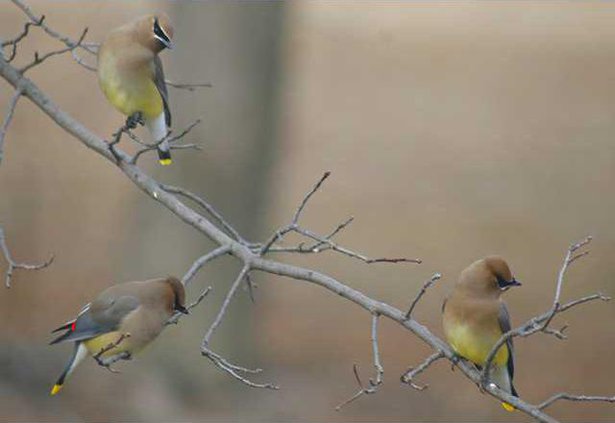Feasting and drinking, mobs of robins and cedar waxwings have found our backyard watering station and cedar trees. Watching them interact right outside the window is much more entertaining than television.
True to their name, the cedar waxwings are feeding on cedar berries in our yard and shelter belt. Not to be left out, the robins are becoming quite plump on the berries too. With so much rain last year, the supply is outstanding and the birds have been in the area most of the winter.
One of my favorite birds, waxwings are striking, exhibiting both bold and subdued coloration. They seem conjured by a painter’s imagination. The cherry-red wax droplets located on their wing feather tips are unique and scientists are uncertain as to their purpose other than to attract a mate. Both sexes exhibit the wax droplets.
When I step outside, I instantly know they’re in the vicinity by their high, clear whistle. The birds are constantly calling to each other. Gregarious, waxwings feed in flocks and also nest together in groups of up to a dozen nests.
Fruit is their favorite food, and unlike most birds they can subsist on a diet of fruit for several months. They also eat insects during the summer months. Eating all of that fruit can have negative results however. They can become intoxicated or even die, if they ingest too much rotting fruit that has begun producing alcohol.
Although they tolerate each other’s company, waxwings become feisty with their robin neighbors. They can be seen sassing robins as they jostle together to drink. Robins and waxwings are found together during the winter because they both share a love of fruit.
All of those birds flocking together means more lookouts for predators and in our yard that means the resident sharp-shinned hawk. If the birds are quiet, it’s a sure bet the hawk is watching from a nearby tree, waiting for the birds to come back.
If the hawk is really hungry, he’ll try flushing birds from their hiding spots. Closer and closer, he’ll dive at the bush, even trying to climb into shrub to grab the birds. If the birds panic, he can grab a meal, but if they hang tight, he goes away frustrated and hungry.
All this drama and it’s happening right outside the window. You can get in on the action too, just by observing the birds in your yard even if you’re not purposefully trying to attract them. If you’d like to join others in this addicting pastime, participate in the Great Backyard Bird Count (GBBC) this weekend.
It’s easy to participate. You’re asked to identify and count the number of birds you see for at least 15 minutes. The results are entered online at: gbbc.birdcount.org. The count runs Feb. 17-20 and you can participate each day or just one. The information gathered from around the country and internationally helps track bird species numbers.
Wetland Explorer
Backyard drama





